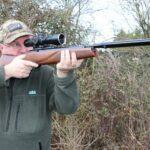Introduction
Estimating the age structure of a population is a key component of many wildlife management programs, as demographic parameters (e.g., survival and fecundity) that can be important to population modeling are typically age-specific [1-3]. Furthermore, age-specific prevalence rates of highly-transmissible diseases (e.g., chronic wasting disease) have been of recent concern [4,5]. The age structure of harvested animals is typically used to reconstruct a population’s age structure, especially in cervid populations [6,7]. Inaccurate estimates of a population’s age structure could lead to potential downstream impacts on demographic and epidemiological models [7,8].
The most common method used to estimate age of white-tailed deer (Odocoileus virginianus) and other cervids is the tooth replacement-and-wear (TRW) criterion. Severinghaus [9] developed the TRW aging criterion for white-tailed deer based on unique teeth eruptions at younger ages and the wear and degradation of the same premolars and molars of the lower jaw at older ages. Aging deer using the TRW method is popular among management agencies because it can be conducted quickly in the field at relatively little cost [10]. Previous studies have shown the TRW method is prone to considerable error because it is partially subjective, especially at older age classes [10-14]. Error in the TRW method at older ages has led to recommendations to implement TRW aging categories for adult white-tailed deer that bin older age classes together: either suggesting the binning of all deer ≥2 years of age together [10,11,14-16] or differentiating deer 2 years of age from deer ≥3 years of age [12,13,17], with both points-of-view suggesting an independent age class for deer 1 year of age (yearlings), since a unique tooth eruption pattern can often identify the age class [9].
A more labor-intensive and expensive, but more accurate, option for aging deer is cementum annuli (CA) aging, which involves the counting of annual rings, the CA, in the roots of cross-sectioned incisors. Seasonal rates of cementum deposition in the root tips that coincide with body growth produce alternating light and dark bands, with the dark bands representing the CA [18,19]. The CA method has been established as a more accurate method than TRW through the comparison of known-age individuals, especially at northern latitudes [11,13,20]. While CA is more accurate than TRW, with the exception of a sample of 97 known-aged deer in Wisconsin that were aged 100% accurately by the CA method [15], error has been documented with CA aging in relation to known-age individuals with error rates ranging from 15-28% in northern latitudes [11,13,20]. While assessing error rates of CA age estimates in comparison to known-age individuals is the only method to identify the accuracy of CA aging for certain, obtaining known-age individuals is difficult outside of captive facilities and capture-recapture studies. In response to the challenges of obtaining actual accuracy rates of CA aging, evaluating the precision between the CA age estimates of multiple incisors from the same deer is an option for samples from wild populations of unknown ages because if factors known to affect CA accuracy can also be shown to be related to the precision of CA aging, the measurement of precision can provide insight related to accuracy of the CA method [10]. Few studies, however, have evaluated the precision of CA ages in white-tailed deer [10,11,21]. While Roseberry [11] and Storm et al. [10] extracted paired incisors from individual deer after harvest, DeYoung [21] extracted separate incisors one or two years apart from live deer. Precision of CA age estimates has also been examined in other cervids such as mule deer (Odocoileus hemionus; [22]) and moose (Alces alces; [23]). Storm et al. [10] and Asmus and Weckerly [22] examined factors influencing the precision of paired CA ages. Factors included the sex of the individual, precipitation during the individual’s life, the level of certainty assigned to the CA age estimates, as well as the age of the CA age estimates [10,22].
Managers must make decisions on how best to use limited resources when deciding on what methodology to use to age deer. Additional information is needed to help resolve whether, excluding fawns, two (yearling, ≥2 years of age) or three (yearling, 2 years of age, ≥3 years of age) age categories should be used if managers decide to rely on TRW for aging. While the accuracy of CA aging has been thoroughly investigated, further evaluation of factors affecting the precision of CA aging is warranted to provide guidance to managers on what factors they must consider when evaluating CA aging data. To that end, the first objective of this study was to evaluate the precision of the CA aging method of paired incisors from wild male white-tailed deer in Iowa. We hypothesized that precision would decrease as the age of the CA age estimate increased, the level of certainty of the estimate decreased, and that precision would be dependent upon the batches in which the teeth were aged, an a posteriori consideration after viewing the CA data. Our second objective was to evaluate factors influencing the level of certainty assigned to CA age estimates. We hypothesized that the level of certainty in the age estimates would decrease with age and be influenced by the batch in which the age estimates were aged. Our third objective was to assess congruence between the age estimates from the CA and TRW methods specifically when deer aged using TRW were aged exclusively as yearling, 2 years of age, or ≥3 years of age. We hypothesized that congruence between the two aging methods would be greatest within the yearling age class and lower for both of the older age classes because the TRW criteria within the yearling age class relies on the presence or absence of a tooth while older ages are determined by a subjective assessment of tooth wear.











































